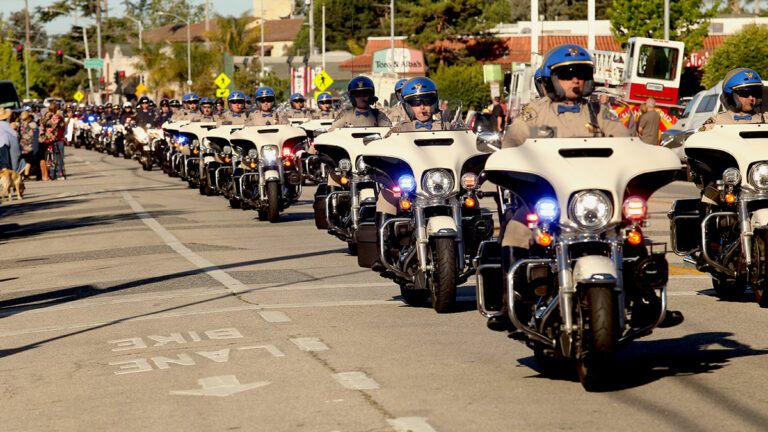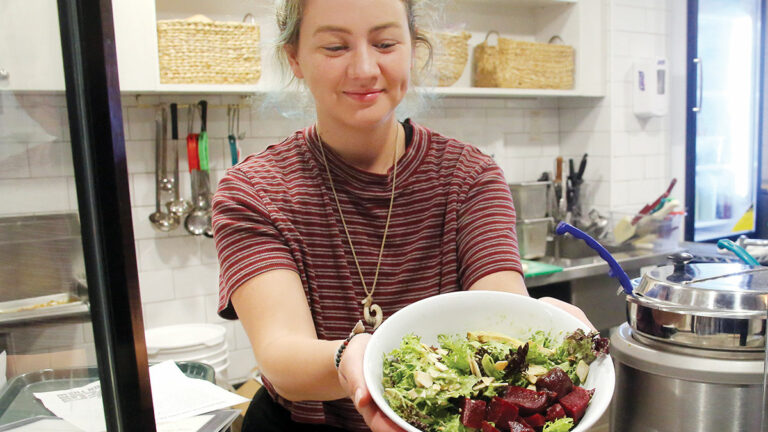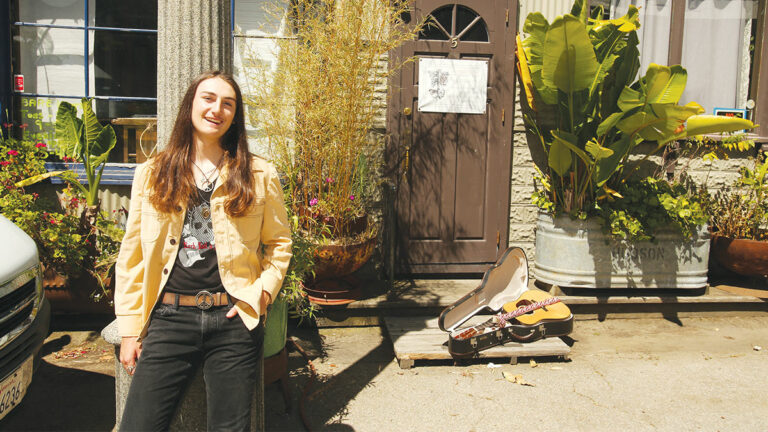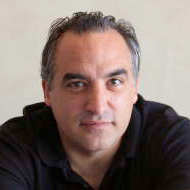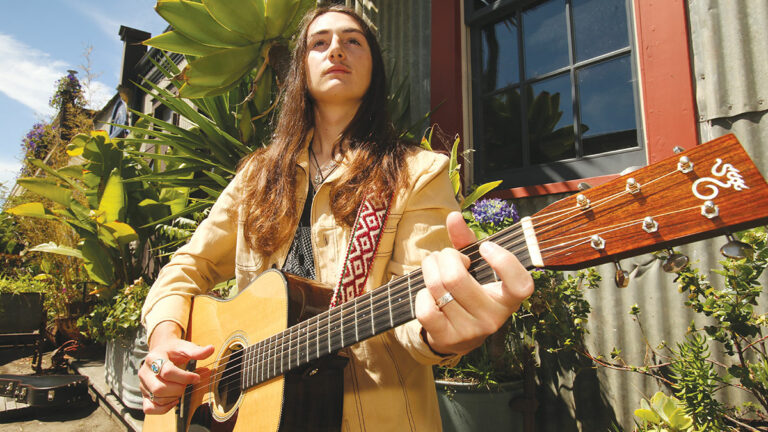His new album is called The Road—a title that, in its simplicity and romance, evokes big themes of restlessness, freedom, longing for an imagined or lost life, the almost limitless possibilities of the future, a Kerouac-ian thirst for experience.
And it fits where Anthony Arya is on his life’s journey just about perfectly.
The young Santa Cruzan is now in that delicious summer between his high-school graduation and his first year in college. He will not turn 18 until September. There are, of course, millions of young people around the world ready to step out onto the road toward their future. But few are more prepared—or starting from a higher point—than this tall, supernaturally talented young musician.
Before he’s even become a legal adult, Arya has already accomplished more than many musicians will in a lifetime. He’s produced two albums of original songs, his 2018 debut Going to California, and The Road, which was released in May. He had a brush with national stardom through several appearances on NBC’s The Voice in 2018. And he leads no fewer than three bands—the Anthony Arya Band that allows him to scratch his itch for blues and rock; Chasing Ophelia, which is a Grateful Dead cover band; and the swing-jazz trio Life is a Cabaret.
That’s on top of a solo career where he’s following his muse as a serious songwriter, and a number of collaborations with many kinds of artists, often exploring inventive new takes on old familiar songs. Since his experience on The Voice, he’s been one of the most active and in-demand musicians on the Santa Cruz music scene, even during the pandemic. He’s also planning a big summer, performing in an online concert with friends and collaborators Lindsey Wall and Taylor Rae on June 20, and a dinner show date at Michael’s on Main in Soquel June 27.
Arya’s got game in the scholastic realm as well. While finishing out his last year at Georgiana Bruce Kirby Preparatory School in Santa Cruz, he was named one of only 20 young people in the country to be U.S. Presidential Scholars in the Arts. In the fall, he’s headed for his freshman year at Stanford University.
Talent, drive, smarts, ambition, imagination, charisma, good looks—all that, and he’s also a really nice guy too.
“I keep waiting for his eyelid to start twitching or something,” laughs San Francisco-based blues artist Preacher Boy, one of Arya’s many collaborators. “But, no. He’s talented and nice, too. Drives me crazy.”
BAY AREA PRODIGY
Arya’s musical journey actually began long before he was born, in the blues clubs of San Francisco’s North Beach neighborhood. That’s where his mom Kamela indulged her abiding love for live blues and such 1990s-era Bay Area heavyweights as guitarist Tommy Castro and band leader Johnny Nitro.
“I always wanted to be a groupie,” says Kamela Arya, a self-employed software consultant who, even after moving to Santa Cruz in 1999, maintained a San Francisco apartment for years.
It was under the influence of his music-loving mom that young Anthony first began soaking up blues and rock. Kamela had studied classical music, and she arranged for piano lessons for her son. But nothing really took until Anthony started playing drums in an after-school rock band as a third-grader at Spring Hill School.
Even then, Kamela says, there is no way she could have predicted that her son would become a musical prodigy. “There was no reason to believe that he was some kind of star or anything. He sang quite nicely for a kid, but nothing special.”
But more musical influences came to bear. Mother and son became big fans of The Voice and Fox’s mega-hit Glee. Anthony took up guitar. At Kirby, new worlds opened up when he joined the choir and began taking his singing seriously. Because Kirby had no rock band, he joined the jazz band. That’s where he fell in love with ragtime and Fats Waller. Eventually, he became a part of the Kuumbwa Honor Jazz Band.
“Jazz really influenced my songwriting,” he says. “Jazz is so improvisational. It can really influence your creativity and it’s very freeing.”
“Jazz was the only type of music that I was unfamiliar with,” his mom says. “He wasn’t even going to do it at first. I was like, ‘Just do it. See what happens.’ I’m a little forceful sometimes.”
It was Kamela who also sparked Anthony’s love of the Grateful Dead—though she admits it took a few tries. “He took a little warming up to the Dead. I just thought his voice was so well-suited for one of Jerry’s songs.”
“Living in Santa Cruz, that’s always been around me,” says Anthony of the Dead. “I remember when I was young, my mom was always playing Grateful Dead music and saying ‘This is so awesome.’ I hadn’t quite caught the bug yet. But I was so wrong then. I’ve been such a huge Dead fan since then.”
Before Anthony’s freshman year at high school, mother and son traveled to Paris. He had not performed for audiences of strangers before, but armed with a backpacker’s guitar, he signed up for a Parisian version of an open-mic night and performed “Hotel California” and other American standards.
Back home, the 14-year-old aspiring guitarist and singer began busking in North Beach, developing his performance chops and discovering the romance of the Beat Generation influence in the area. All the while, Kamela was taking her son to see live performances in San Francisco and closer to home at clubs like Don Quixote’s in Felton.
‘VOICE’ LESSONS
Kamela and Anthony had already been watching The Voice for years when Anthony decided to submit an Instagram video to the show’s casting call. (Anthony was an accomplished athlete growing up, particularly at baseball, and he credits one of his baseball coaches for giving him the idea for his audition, Paul Simon’s cheeky hit “Fifty Ways to Leave Your Lover.”).
The Instagram video got Anthony an invitation to the show. The Aryas traveled to Los Angeles in the summer of 2018, where they were quarantined per the show’s rules. Soon, the 15-year-old Santa Cruzan found himself in front of a screaming audience and national TV cameras singing Kenny Loggins’s “Danny’s Song.” He found an early champion in one of the show’s hosts, Maroon 5’s Adam Levine. “I’m telling you right now,” Levine said to Arya on the show, “your whole situation, the way you engage with an audience, you are so special, dude. People are going to fall madly in love with how you do it.” Kelly Clarkson told him he looked like “a Greek god.” He also sang Jim Croce’s ballad “Operator” and Pure Prairie League’s “Amie” before being eliminated on the show.
“My mom would always push me to perform when I was younger,” Arya says. “Busking on the streets of San Francisco, you really had to give a performance to get people passing by to really pay attention to you just for a second. I think all those years that I spent doing that kind of thing helped me when I stepped on that stage for The Voice. Also, I was just having a whole lot of fun.”
CONNECTING IN SANTA CRUZ
After The Voice, inflamed by an obsession with the artistry of Bob Dylan, he began to get serious about his songwriting. At the same time, partly because he had to learn so many cover songs for The Voice, he began to collaborate with other musicians like Taylor Rae, Emily Hough and Lindsey Wall. He performed at themed nights at the Food Lounge in Santa Cruz.
Kamela made the connection between her son and blues artist Preacher Boy, a much older musician steeped in the kind of blues that Anthony was keen to learn.
“When he showed up, it was like looking in a mirror at a younger self,” says Preacher Boy. “He walked through that door, raggedy hair and cowboy boots, carrying that old resonator guitar with a slide on his finger. It was one of the first times when I felt that maybe there’s something to this passing-on-the-torch idea.”
Lindsey Wall, who had auditioned for American Idol shortly after Arya’s stint on The Voice, began to perform duets with the younger singer, playing together on such songs as “Angel From Montgomery” and “I’m On Fire.”
“I think you can hear how old his soul is in his music,” she says. “He seems so … weathered, in a good way. He has such wisdom in the way he carries himself.”
“He’s got a really singular blend of humility and confidence,” says Preacher Boy. “He steps into situations that I never would have had the guts to step into. And he does it with maximum politeness. He’s not a cocky gunslinger. But he’s also absolutely fearless about getting up and strutting his stuff.”
Quinn Becker is another musician friend who occasionally jams with Arya. “Anthony has this insane ambition,” he says. “I was playing music with him once recently, and he told me he was learning ‘Black Water’ by the Doobie Brothers. The next day, he sent me this fully recorded video of him doing that song he had just made himself. A lot of people want to be famous, but they don’t want to put in the work that you have to do. He does the work.”
“Because of his mom, he’s been exposed to a lot,” says Preacher Boy. “He’s had the benefit of a great education. It’s not surprising that he’s achieved a level of prowess at his age. The extent to which the external world is fascinated by the fact that he’s tall and thin and good-looking and young, those are all the things that the media likes. But in my experience, I don’t see him trading on that stuff. It’s a pleasant coincidence that he’s also putting in the work.”
His mom says that Arya “talks about Bob Dylan every day.” Though he continues to play guitar almost constantly, the young musician is going ever deeper into his songwriting, and it’s evident in The Road, in mid-tempo rockers like “Moonlight” to pretty and lilting melodies like “California Air.”
On his way to Stanford in the fall, Arya is preparing to major in American Studies, as well as music and computer science. American art and history has seduced him, and he hopes that learning more about history will liberate his songwriting muse.
“What I’m going to be studying, American Studies, is going to help my songwriting,” he says. “I’m not going to be hitting the road as much if I’m attending Stanford. But being able to focus on my songwriting and to be inspired by the history that I study is very important to me. We’ll see what happens.”
Anthony Arya will livestream a Lille Aeske-hosted performance with Lindsey Wall and Taylor Rae on Saturday, June 20, 5-7pm, to Facebook Live, YouTube and Twitch. Tickets, $5 to $10. Venmo: @lilleaeske. Paypal: ar**@********ke.com. lilleaeske.com. He will also perform live in person on Saturday, June 27, 6:30-10:30 pm at Michael’s on Main, 2591 Main St., Soquel. $45 dinner and a show. Concert-only tickets not available. michaelsonmainmusic.com.



